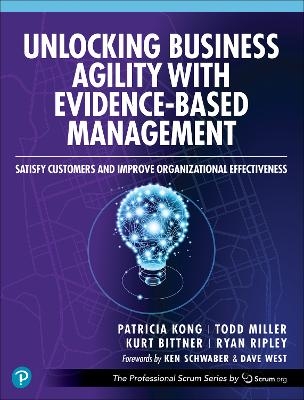
Unlocking Business Agility with Evidence-Based Management
Addison Wesley (Verlag)
978-0-13-824457-6 (ISBN)
Organizations often believe in the certainty of their plans and see every deviation from the plan as a sign of failure. They view the organization as a machine for creating and executing plans instead of looking at it as a responsive organism, attentive to the changes in its environment. In a world of uncertainties, organizations need to be capable of reinventing themselves every day based on new information.
In Unlocking Business Agility with Evidence-Based Management, authors Patricia Kong, Todd Miller, Kurt Bittner, and Ryan Ripley use the framework developed by Scrum.org called Evidence-Based Management (EBM). EBM is an empirical approach that helps organizations use experimentation and rapid feedback to progress toward goals. This path is not always obvious or straightforward, but that is a benefit: in a complex and changing world, the path toward goals will always be uncertain. EBM helps organizations use new data to adapt their plan toward their goals.
Throughout the book, the authors present stories and experiences that illustrate how EBM can be applied to set better goals and then leverage empiricism to achieve those goals using feedback, learning, and evidence. This definitive guide will help your organization identify its true purpose, improve its ability to reach goals, and build a culture of trust, transparency, and growth.
Clarify goals and demonstrate value, success, and progress using agile metrics
Progress toward goals in uncertain and rapidly changing circumstances
Embrace empiricism and experimentation to find solutions for complex problems
Find real-world anonymized case studies on how to articulate goals and measurements in a way that fosters self-management and business agility
Register your book for convenient access to downloads, updates, and/or corrections as they become available. See inside book for details.
Patricia Kong helps organizations thrive in a complex world by focusing on enterprise innovation, leadership, and teams. She is a people advocate and fascinated by organizational behavior and misbehaviors. She is co-author of The Nexus Framework for Scaling Scrum (Addison-Wesley, 2017). Todd Miller has practical experience as a Scrum Master, Product Owner, Software Developer, and Agile coach on a variety of technical and creative projects across a multitude of industries. He has been a professional Scrum trainer with Scrum.org since 2016. Kurt Bittner has been delivering working products in short, feedback-driven cycles for more than 40 years, and has helped many organizations do the same. He is particularly interested in helping people form strong, self-organizing, high-performance teams that deliver solutions that customers love, and helping organizations use empirical feedback to achieve customer outcome-focused goals. Ryan Ripley is a Professional Scrum Trainer with Scrum.org, and has experience as a software developer, manager, director, and Scrum Master at various Fortune 500 companies in the medical device, wholesale, and financial services industries. He is the host of "Agile for Humans," the top agile podcast on iTunes. He recently co-wrote Fixing Your Scrum: Practical Solutions for Common Scrum Problems (Pragmatic Bookshelf, 2022).
Foreword by Ken Schwaber xi
Foreword by Dave West xv
Preface xix
Introduction xxvii
Chapter 1: Finding Purpose 1
Rediscovering Purpose 3
Goals 4
How Goals and Measures Influence Behaviors 7
How to Rediscover Purpose 10
Closing Satisfaction Gaps Creates Value 11
Customer-Focused Goals Enable Autonomy and Purpose 14
Improving Strategic Goals 17
Ask “Why?” to Uncover the Real Objective 17
Refocus “Internal” Goals on What Customers Need to Experience 19
Think About How You Will Measure Progress Toward Your Vision 20
What to Watch For 21
Moving Forward 22
Chapter 2: Using Empiricism to Progress Toward Goals 23
Understanding Value 25
Progressing Toward Goals in a Series of Small Steps 27
Taking Small Steps Toward Goals 29
Steering Toward Goals 32
Adapting Goals 34
Adapting Tactics 36
The Real Purpose of Goals Is to Foster Conversations 36
Losing the Plot and Finding It Again 37
What to Watch For 38
Moving Forward 39
Chapter 3: Becoming (More) Effective 41
Value Is Essential, but Frequency Matters Too 42
It Is Not Delivery Speed That Is Important; It Is Feedback Speed 44
While Focusing on Speed, Do Not Lose Sight of Value 45
Speed Is Not Enough; Teams Must Also Be Effective 46
Too Many Things at Once 48
Where Should Teams Start? 50
Beware the Efficiency Trap 51
Balancing Speed and Effectiveness 52
Cutting Corners: Sometimes Necessary, Sometimes Fatal 53
What to Watch For 55
Moving Forward 56
Chapter 4: Managing and Overcoming Expectations 59
People Who Largely Seek to Validate Expectations Are Often Disappointed 60
Transforming “Bad News” into Just “News” 61
Letting Go of Expectations 64
Expectations Can Be Stubbornly Held 65
Replacing “Meeting Expectations” with “Seeking Goals” 68
Stakeholders and Transparency 69
How to Define and Categorize Stakeholders 70
Escaping the “Echo Chamber” 73
Diverse Perspectives Counter “Groupthink” 76
What to Watch For 77
Moving Forward 78
Chapter 5: Separating the Signal from the Noise 81
Identifying Signals 82
Interpreting Evidence from Signals 84
Dampening the Noise 85
Bias Creates Noise 88
The Customer Is Not Always Right 90
Objectifying Narratives 92
Getting Unstuck 94
Making Decisions 96
What to Watch For 97
Moving Forward 98
Chapter 6: Applying EBM at the Product Level 99
Mind the (Satisfaction) Gap 100
When You Find Yourself in a Hole, Stop Digging 101
Not All Ideas Are Valuable 103
Replacing False Certainty with Experimentation 104
Using Strategic Goal Mapping to Form Experiments 106
Products Are Vehicles for Running Experiments About Value 108
Sometimes Teams Lose the Thread and Need a Reminder 110
Running Experiments and Measuring Results 111
Inspecting Results and Adapting Next Steps 114
Customer Experience Is Not Always About More Features 117
Sometimes You Must Say No 120
What to Watch For 121
Moving Forward 122
Chapter 7: Applying EBM at the Portfolio Level 123
Maximizing Output Does Not Maximize Value 124
The Problems Start with Misfocused Goals 126
Revenue and Profit Are Important, But They Are Poor Goals 127
Reconnecting Investments with Customer Outcomes 128
You Can't Have It All at Once 129
How to Measure Outcomes 130
You Do Not Know What You Do Not Know 131
How to Choose Between Bets 132
Make Small Bets 133
Kill Bad Ideas as Quickly as Possible 135
Propose Experiments 138
Evaluate Proposals 139
Make Sure All the Cards Are on the Table 140
Keep Teams Intact, and Bring Them Work 140
Separating Budgeting from Funding 141
Run Experiments 141
Evaluate Progress Toward Goals 141
What to Watch For 144
Moving Forward 145
Chapter 8: Applying EBM at the Organizational Level 147
Why Change Efforts Fail 148
To Initiate Change, Give People a “Why” 149
Assess Where the Organization Is Today 150
Empowerment Takes Trust, Transparency, and Time 152
Benefits of Empowering Teams 153
Measuring Empowerment 154
Growing Empowerment 155
Inverting the Organization to Support Empowerment 156
Reducing Context Switching 157
Growing Self-Sufficient Teams 158
Aligning Supporting Departments 160
Setting and Adapting Goals 163
Most Goals Can—and Should—Change 163
What to Watch For 164
Moving Forward 165
Index 167
| Erscheinungsdatum | 05.11.2023 |
|---|---|
| Reihe/Serie | The Professional Scrum Series |
| Verlagsort | Boston |
| Sprache | englisch |
| Maße | 180 x 230 mm |
| Gewicht | 402 g |
| Themenwelt | Mathematik / Informatik ► Informatik |
| Wirtschaft ► Betriebswirtschaft / Management ► Projektmanagement | |
| ISBN-10 | 0-13-824457-X / 013824457X |
| ISBN-13 | 978-0-13-824457-6 / 9780138244576 |
| Zustand | Neuware |
| Haben Sie eine Frage zum Produkt? |
aus dem Bereich


